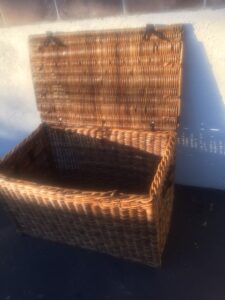 JP sent me a photo of a huge linen hamper, four by five-and-a-half feet of woven willow, which indicates a European origin. People saw these beasts in hotel corridors in the late 19th and early 20th centuries. Chambermaids loaded them with dirty towels, sheets, tablecloths, rugs, etc., in the mornings. Think of them as cousins to 21st century hotel corridor cart.
JP sent me a photo of a huge linen hamper, four by five-and-a-half feet of woven willow, which indicates a European origin. People saw these beasts in hotel corridors in the late 19th and early 20th centuries. Chambermaids loaded them with dirty towels, sheets, tablecloths, rugs, etc., in the mornings. Think of them as cousins to 21st century hotel corridor cart.
I must say JP this hamper brings back memories for me. In my early thirties, as a new mom, I worked in theater set design I made an exchange with another designer from Russia. I took her job for a season in Moscow, and she took mine in California. My son and I stayed at the Hotel Budapest.
In the evenings I monitored the performance. The cleaning ladies occupied my little son by scooting him around the hotel corridors in one of these huge wicker hampers mounted on wheels. I imagine him on a pile of dirty sheets, the two babushkas pushing the hamper. When I arrived back at the hotel, I found my son asleep on the linens in such a hamper in the tearoom where the babushkas kept a samovar constantly brewing.
This Hamper Also Originated in a Hotel
I bet it came from French, as many extant do. They sell for $700 – $1,500 to collectors of old wicker.
Housekeepers loaded whole roomfuls of linen throughout a hotel in such hampers. JP’s hamper sports hand forged wrought iron hinges and latches. I pegged them as hand hammered because of their asymmetrical appearance, as opposed to mold “cast.” The basket is darkened aged willow, never painted. Try stripping paint off wicker! All this adds up to a lovely white elephant piece of Folk Art.
We see some hampers with the initials of the hotel emblazoned. Some don’t come with lids, instead a padded fabric bumper protects hotel walls. Some have wicker handles, some rope handles. JP’s has leather handles. Hampers with two wheels on the bottom were levered to roll (That was how my little son got around the Hotel Budapest!).
Journey of Linen In Hampers in Late 19th Century Hotels
First staff soaked white linen overnight. They soaped the linen, then boiled, rinsed, wrung and or mangled, then dried. Air dry because no such thing as a dryer existed. Then starch and iron. A mangle was necessary of course, and in winter months, usually a hotel had a drying room with hoists to raise the linens to air dry. Imagine long bars loaded with linen and pulleyed up for rows and rows. Usually, this room was close to the boiler room of a big hotel.
If reading the process makes you feel exhausted, and thankful for your electric washer and dryer, you should know linen workers all needed extraordinarily strength. Laundry workers, either robust women, called “washerwomen,” or hefty men, called “fullones,” hand cranked washing machines in such hotels in those days. The huge tub required a stove close by for heating and pouring water. No water heater in the washing machine back then. Workers fitted huge tubs with paddles on rods cranked by hand. Think of the friction a hundred sheets in one tub caused.
Most hotels operated an in-house laundry, but in New York City, as Chinese immigrants opened commercial laundries, some hotels outsourced the linen. The long arduous process, and the weight of soiled linen and the labor involved still seemed daunting.
Every morning, chambermaids collected massive loads of dirty towels, sheets, tablecloths, and sometimes uniforms in JP’s hamper. Staff used some hampers to collect guest’s clothing, which they hand laundered. By the way, if today you stay in a classy hotel, they often offer a laundry service such as this for your garments, but the bill will equal the room tariff, I bet.
The value of JP’s hamper is $700. She writes that she recently washed and restored it with boiled linseed oil, the perfect “drink” for such a thirsty hamper.
Pingback: A Washboard Eased Laundry Day Ordeal - Elizabeth Appraisals